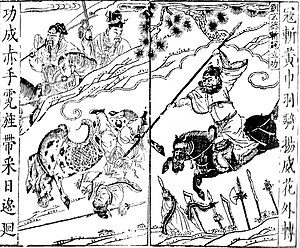Yellow Turban
| Yellow Turban Rebellion | |||||||
|---|---|---|---|---|---|---|---|
| Part of the wars at the end of the Han dynasty | |||||||
 A Qing dynasty illustration of the novel Romance of the Three Kingdoms, showing Liu Bei, Zhang Fei, and Guan Yu fighting Yellow Turban rebels |
|||||||
|
|||||||
| Belligerents | |||||||
| Han dynasty | Yellow Turban rebels | ||||||
| Commanders and leaders | |||||||
|
Emperor Ling He Jin Liu Bei Huangfu Song Lu Zhi Zhu Jun Cao Cao Sun Jian |
Zhang Jue Zhang Bao † Zhang Liang † Zhang Mancheng † Bo Cai † |
||||||
| Strength | |||||||
| 350,000 | 2,000,000 (360,000 were initially followers of Zhang Jue) | ||||||
| Casualties and losses | |||||||
| Death toll said to be from 3–7 million | |||||||
| Yellow Turban Rebellion | |||||||||
| Traditional Chinese | 黃巾之亂 | ||||||||
|---|---|---|---|---|---|---|---|---|---|
| Simplified Chinese | 黄巾之乱 | ||||||||
| Literal meaning | "Yellow Turban Conflict" | ||||||||
|
|||||||||
| Transcriptions | |
|---|---|
| Standard Mandarin | |
| Hanyu Pinyin | Huángjīn zhī luàn |
| IPA | [xwǎŋtɕín ʈʂɨ́ lwân] |
The Yellow Turban Rebellion, also translated as the Yellow Scarves Rebellion, was a peasant revolt in China against the Han dynasty. The uprising broke out in the year 184 during the reign of Emperor Ling. It took 21 years until the uprising was fully suppressed in the year 205. The rebellion, which got its name from the color of the cloths that the rebels wore on their heads, marked an important point in the history of Taoism due to the rebels' association with secret Taoist societies. The revolt was also used as the opening event in Luo Guanzhong's historical novel Romance of the Three Kingdoms.
A major cause of the rebellion was an agrarian crisis, in which famine forced many farmers and former military settlers in the north to seek employment in the south, where large landowners exploited the labor surplus to amass large fortunes. The situation was further aggravated by smaller floods along the lower course of the Yellow River. The peasants were further oppressed by high taxes imposed in order to fund the construction of fortifications along the Silk Road and garrisons against foreign infiltration and invasion. In this situation, landowners, landless peasants, and unemployed former-soldiers formed armed bands (around 170), and eventually private armies, setting the stage for armed conflict.
At the same time, the Han central government was weakening internally. The power of the landowners had become a longstanding problem, but in the run-up to the rebellion, the court eunuchs in particular gained considerably in influence over the emperor, which they abused to enrich themselves. Ten of the most powerful eunuchs formed a group known as the Ten Attendants, and Emperor Ling referred to one of them (Zhang Rang) as his "foster father". The government was widely regarded as corrupt and incapable and the famines and floods were seen as an indication that a decadent emperor had lost his mandate of heaven.
...
Wikipedia
